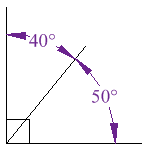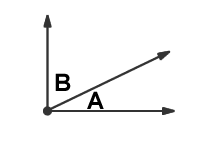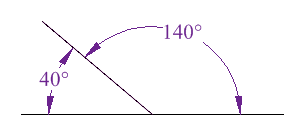Angles
Monday, June 7, 2010
Reply to Comments
References
Types of Angles | Different Types of Angles | TutorVista.com . (n.d.).Tutorvista.com - Online Tutoring, Homework Help for Math, Science, English from Best Online Tutor. Retrieved March 5, 2010, from http://www.tutorvista.com/content/math/geometry/angles_at_a_point/class9maths2.php
Angles Cartoons and Comics. (n.d.). CartoonStock - Cartoon Pictures, Political Cartoons, Animations.. Retrieved March 8, 2010, from http://www.cartoonstock.com/directory/A/Angles.asp
Geometry. (n.d.). Math is Fun - Maths Resources. Retrieved March 5, 2010, from http://www.mathsisfun.com/geometry/index.html
Kelly, K., & Zeman, A. (1997). Angles. Everything You Need To Know About Math Homework (Evertything You Need To Know..) (pp. 96-98). Cincinnati: Scholastic Reference.
Protractor Clipart. (n.d.).Educational Technology Clearinghouse . Retrieved March 8, 2010, from http://etc.usf.edu/clipart/25700/25799/protractor_25799.htm
Unit 11 Section 1 : Angle Measures. (n.d.). Centre for Innovation in Mathematics Teaching. Retrieved March 8, 2010, from http://www.cimt.plymouth.ac.uk/projects/mepres/book8/bk8i11/bk8_11i1.htm
front, t. t., & which, t. a. (n.d.). CHICOS. California HIgh school Cosmic ray ObServatory. Retrieved June 6, 2010, from http://www.chicos.caltech.edu/cla
Sunday, June 6, 2010
Complementary and Supplementary Angles




Suppose angle A is 85°. So, to find angle B you would subtract. 180° - 85° = 95°
How can you remember which is which? Easy! Think:
- "C" of Complementary stands for "Corner"
 (a Right Angle), and
(a Right Angle), and - "S" of Supplementary stands for "Straight" (180 degrees is a straight line)


Monday, March 8, 2010
Measering Angles with protractors
The outer scale starts from 0° to180° going clockwise.

- - place the origin or center (the part that is marked with the letter O on the left protractor, the small hole on the right protractor) part of the protractor on the vertex of the angle.
- - Make sure that the base line on the protractor is lined with the arm of the angle.
- - Check which numbers the other arm crosses over in the protractor. There are 2 sets of numbers that run along the protractor. Sometimes the arms of the angles are not long enough for the protractor, if that is the case then extend the arms with a ruler.
- - Now, look at the angle you are measuring and ask yourself: "self is the angle an acute angle or an obtuse angle?"
- - If the angle is acute or less than 90°, take the smaller number. If the angle is obtuse or greater than 90°, take the bigger number.

Step 1: Place the center or origin of the protractor on the vertex B.
Step 2 : Adjust the base line so that it is aligned with the line BC.
Step 3: Look at the numbers the angle crosses on the protractor. The
numbers are 60 and 120.
Step 4: Ask yourself: "self, is this an obtuse or an acute angle?"
Step 5: It is an acute angle, so you would take the number in the inner
scale 60°.
Now, it is your turn, try it yourself!
Measure the following angles. Highlight the section below and print the selection.


Source: (Centre for Innovation in Mathematics Teaching: http://www.cimt.plymouth.ac.uk/projects/mepres/book8/bk8i11/bk8_11i1.htm)

Friday, March 5, 2010
Types of Angles
An angle is comprised of two rays that share the same endpoint. The two rays are called thearms of the angle. The point where the arms intersect is called the vertex. Look at the following example.

Source: (Tutor Vista:http://www.tutorvista.com/content/math/geometry/angles_at_a_point/class9maths2.php)
 and
and  are called arms of the angle BAC. The point 'A' is called the vertex. The angle formed by the two rays AB and AC is represented by the symbol
are called arms of the angle BAC. The point 'A' is called the vertex. The angle formed by the two rays AB and AC is represented by the symbol  BAC. . If there is only one angle at A, then the angle BAC may be represented by
BAC. . If there is only one angle at A, then the angle BAC may be represented by 
- Acute angle: angle that is less than 90°.
- Right angle: angle that is exactly 90°.
- Obtuse angle: angle between 90°-180°.
- Straight angle: angle that is exactly 180°.
- Reflex angle: angle between 180°-360°.
- Revolution: a 360° angle, a full rotation.
The following images are examples of each type of angle.
source: (math is fun: www.mathsisfun.com/geometry/index.html)
Now, its your turn, try it yourself!
Look at the image below and answer the following questions to practice and work on what you have just learned.

Source: (Tutor Vista:http://content.tutorvista.com/maths/content/geometry/lines%20angles%20triangles/images/img42.gif)
1. How many acute angle(s) are there? Name three.
2. How many obtuse angle(s) are found? Name 3.
3. How many right angle(s) are found? Name them.
4. How many reflex angle(s) are found? Name them.
5. Name the straight angle.
6. Give an example of a full rotation angle.



